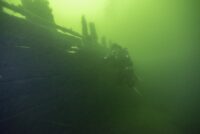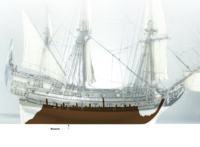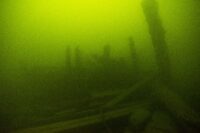 Two wrecks of 17th century warships discovered in the straits outside the island of Vaxholm, Sweden, have been identified as Apollo and Maria, built in 1648. When they were first found in autumn 2019, archaeologists thought one of them might be the Äpplet, the twin sister of the warship Vasa that sank in ignominy on its maiden voyage in 1628 only to be raised in 1961 and become one of Sweden’s most-visited tourist attractions. Analysis of wood samples, detailed measurements and archival research contradicted that initial hypothesis and pinpointed the two scuttled warships’ real identities.
Two wrecks of 17th century warships discovered in the straits outside the island of Vaxholm, Sweden, have been identified as Apollo and Maria, built in 1648. When they were first found in autumn 2019, archaeologists thought one of them might be the Äpplet, the twin sister of the warship Vasa that sank in ignominy on its maiden voyage in 1628 only to be raised in 1961 and become one of Sweden’s most-visited tourist attractions. Analysis of wood samples, detailed measurements and archival research contradicted that initial hypothesis and pinpointed the two scuttled warships’ real identities.
“Identifying the ships has been a real mystery to solve, and there were many pieces that needed to fall into place,” says Jim Hansson, maritime archaeologist and project manager for the dives at Vaxholm. “These are large ships with impressive dimensions. We took a number of wooden samples for age dating purposes, and the results show that the oak the ships were built with was felled during the winter of 1646/47. This means that the ships should have been built one or two years later.”
Hansson continues:
“When we dived on the ships, we got ‘a Vasa feeling’ – the timbers were huge, so one clue pointed to the possibility of finding some of Vasa’s sister ships, which we know were sunk outside Vaxholm. But the dates didn’t add up. Vasa’s sister ships, Äpplet, Kronan and Scepter, were built shortly after Vasa sank in 1628. We wondered if the samples we had taken could have possibly come from parts of the ships that had been repaired, in the 1640s.”
The maritime archaeologists starting diving again, taking more samples for analysis that clearly showed that both ships must have been built from oak felled during the winter of 1646/47. The oak from one ship came from northern Germany and the other from eastern Sweden.
 Apollo was built in Wismar, Germany, and Maria at Skeppsholmen shipyard in Stockholm. They served in the Second Northern War and were sent to Poland-Lithuania as part of the Swedish Deluge (invasion) of Poland. Both ships took part in the Battle of Møn in 1657 and the Battle of the Sound in 1658. They were deliberately scuttled at Vaxholm in 1677 to act as defensive barriers against any enemy ships attempting an attack on Stockholm through the narrow straits.
Apollo was built in Wismar, Germany, and Maria at Skeppsholmen shipyard in Stockholm. They served in the Second Northern War and were sent to Poland-Lithuania as part of the Swedish Deluge (invasion) of Poland. Both ships took part in the Battle of Møn in 1657 and the Battle of the Sound in 1658. They were deliberately scuttled at Vaxholm in 1677 to act as defensive barriers against any enemy ships attempting an attack on Stockholm through the narrow straits.
 The ships were smaller than the Vasa-class giants loved by King Gustav II Adolf. His bigger-is-better philosophy was abandoned after his death in 1632 and Swedish warships shifted to a more moderate size but built robustly enough to support heavier artillery.
The ships were smaller than the Vasa-class giants loved by King Gustav II Adolf. His bigger-is-better philosophy was abandoned after his death in 1632 and Swedish warships shifted to a more moderate size but built robustly enough to support heavier artillery.
“It’s interesting to get to tell about these ships,” Hansson says. “The type of ships that Apollo and Maria represent have never before been documented archaeologically, and they have so much knowledge to convey,” he concludes.
Marine archaeologists will continue to explore the Vaxholm area which is replete with wrecks. They’re still looking for Vasa’s sister among many others including captured Danish vessels.